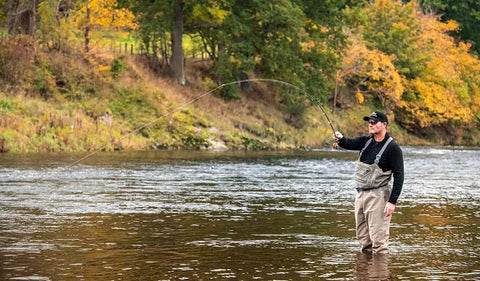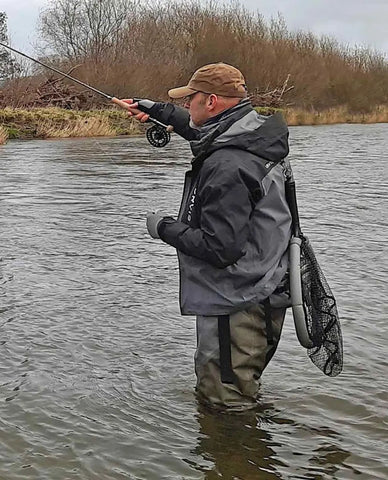Euro Nymphing for Grayling in Scotland - Stewart Collingswood
In Scotland, we are blessed with 30,000 trout-filled lochs as well as storied salmon rivers like the Spey, Tay, Tweed, and Dee. What’s not well publicized, are Scotland’s world class grayling rivers. I’m the founder of Alba Game Fishing, chief cook, bottle washer, skivvy, and fishing guide. My focus from late October is the Lady of the Stream, the grayling.
Grayling are not native to Scotland; they were introduced to the River Clyde from Derbyshire (East Midlands of England) in the mid-1800s, and then by enthusiasts and anglers to the River Annan, Ayr, Earn, Nith, Tay, Teviot and Tweed, where they thrived and spread to some of their tributaries.

Steering a good grayling to the slacker water with side pressure.
These magnificent fish provide year-round sport and a welcome winter species to target after the end of the trout and salmon season.
Scotland has some of the finest grayling rivers in Europe. The two main rivers we target in the winter are the River Annan in the southwest, and The River Tweed system in the Scottish Borders region. These waters hold healthy stocks of wild grayling and are within easy reach of my hometown of North Berwick, near Edinburgh.

Scottish Grayling.
How Do Grayling Feed? Are They Easy to Catch?
The grayling is a soft-mouthed bottom feeder; “a grub muncher,” we say. Their mouth is downturned, aiming towards a diet of nymphs, larvae and shrimp. Smaller grayling will occasionally take a dry fly, extending their body almost vertically in the water column to do so.
Grayling can throw the hook easily, especially as we fish barbless. The combination of a sail-like dorsal fin and soft mouth allows them to easily evade capture. Therefore, it pays to play these fish carefully, with a supple, forgiving rod. I prefer a 10’, 2-weight rod (such as the Orvis Clearwater and Sage ESN) that can soak up sudden lunges by a bigger fish.
A box of grayling candy will include variety of nymphs in different weights. These nymphs should represent caddis larvae, Rhyacophilid, Ephemerid and shrimp patterns. Then there’s the dirty section of the box—weighted salmon eggs and squirmy worms, which work well in the right conditions.

Grayling candy.
When you come to fish a run, select a nymph which bounces along the bottom. The heavier heads will sink quicker in higher water. In low, clear water, it pays to go down to the smaller, more imitative nymphs.
I prefer fishing a team of three nymphs, using a small profile fly on the top dropper. In a pool with a uniform bottom, the flow of water just below the surface is faster than on the riverbed. A smaller fly in the faster current equals less drag and a more natural presentation.
Using a weighted caddis pattern on the point fly when fishing a 3-fly cast, there are two droppers above, each 12-inches apart.
Best Waders, Boots, and Clothing for Grayling Fishing
Fishing for grayling often demands a lot of walking in waders, so it’s best to travel light. I carry a small Patagonia pack containing tippet, flies and spare indicator material.
I use a Living the Dream landing net attached to my Orvis Pro Wading jacket. I carry only one box of carefully selected nymphs and a bottle of water. I don’t eat when I’m fishing, I’m far too engrossed. The winter days are short enough to fish for 6 hours with focus and determination. It’s not a picnic.
Some grayling anglers swear by the warmer neoprene waders when fishing in the winter, but these can be cumbersome and difficult to walk in. I prefer Orvis Pro Guide waders and multi layers of thermal leggings.
Vibram soled wading boots with PosiGrip Tungsten studs give you the best footing. You’ll have a good grip on the river bed and the river bank. Felt soled boots are quiet on the river bed, and grip well. But they offer no grip on the river bank. You need to be surefooted when wading in the winter months, as a dip in the icy water can spoil your day.
Winter fishing can be hard on the hands. Fingerless gloves are essential. I also carry a pair of warmer thermal gloves (with fingers) which I put on when walking between pools.
If you’re a beginner reading this, make sure your wading belt is very tight. Also recommended is an auto-inflatable life vest.
When you hook a big grayling, its strength will surprise you. The huge, sail-like dorsal fin uses the current for purchase, so it’s best to steer the fish into slacker water.
An Ideal Grayling Leader Set Up
There are various ways to construct a leader when Euro nymphing. I’m not a fan of tapered leaders, which are thicker and prone to wind resistance.
I like the Mastery Nymph line or the Orvis Nymph line. Both are low diameter and of excellent quality. The only time the fly line is outside my rod tip, is when a big fish strips line off the reel.

Euro nymph Leader Construction.
I tie a 20’ length of 8lb breaking strain Amnesia to the fly line. This is my main casting line. I then attach a 12-18” length of indicator tippet, using a three run dropper knot. I cannot stress enough the importance of choosing the right tippet material when fishing for grayling. Consider Fulling Mill Masterclass and Lazer Shogun monofilament, which are supple and strong for their small diameter. If you trim the tags, make sure you leave a small section of Amnesia on the upper end. This is then looped with a simple granny knot to stick out at 90 degrees. This serves as another good sight indicator.
The leader length varies according to the depths at which you are fishing. Generally, I fish with a 10’ leader and three flies, the heavier jig fly on the point.
Techniques for Euro Nymphing
Euro nymphing, or straight line nymphing, is a method where you cast mono to propel the flies toward the target. With no fly line outside the tip of the rod, there is less resistance and a greater sensitivity and awareness of subtle takes.
A 10’ or 11’, 2 or 3-weight rod is ideal for this method, and gives you better control of the flies.
The technique is to pitch your flies upstream and aim for a drag free drift. You hold your rod tip up, and suspend your dropper nymphs, while letting the tail nymph bounce on the bottom. Your sight indicator should be just above the water line—visible enough to see subtle takes. The takes come in different guises.
The ‘Stop Take’ is when the nymph just stops progressing downstream. Other times the grayling takes with more gusto and the rod lunges over. There are also subtle takes, indicated by a small pluck on the line. This is where a sensitive rod, like a 2-weight wins.
Casting with Nylon, How to Avoid Tangles
It can be tricky casting two or three flies using nylon alone. When you are learning this technique, some tangles are unavoidable. Find a technique that works for you, and try to get into a casting rhythm that succeeds.
When casting, you should see three visible rings on the surface when the nymphs land. If not, stop immediately—usually two of the flies are tangled together. It’s much easier to sort out the tangle if you stop right away.
Always strike downstream, as this delivers better hook ups. Fish face upstream (obviously) so as the nymph is hoovered up, a swift downstream strike sets the hook more often on the scissors rather than the front of the mouth.
How to Read a River for Grayling
Start by asking yourself: where do you think an abundance of food will be channeled? Some of the best grayling spots are close to a pool that offers cover during a flood. Grayling like uniformity and a gravel bottom.
Foam on the surface is a great indicator of how food is channeled. Try to visualize the river bed. When exploring beats, build a picture of holding spots for fish. Of course, rivers change yearly, so renewing this awareness is key.

Euro nymphing for grayling on the Teviot Water, near Edinburgh.
If you find fish and catch a few, sometimes the grayling can get spooked and head upstream. Rest the pool for a bit, walk upstream, and sometimes the action begins again.
Be aware also that as the river level rises fish are less likely to stay in the same runs. During a spate, the fish will seek cover of deep eddies and slower seams. Try to think like a fish. Where would you go to get food? Where would you shelter? Where can you get flow, food and oxygen, without too much effort to hold in the current?
Remote Rivers with Few People
When fishing in Scotland for grayling you will seldom see other anglers. The rivers we target are quiet. You can walk six miles and not see another person. Grayling can shoal, but are often nomadic and solitary, so it pays to move around to prospect fish.
Stay positive and mobile if you struggle to find fish. Often it will surprise you where fish get caught, so keep an open mind. Look for a strong current on the far bank and a lovely seam running on the nearside over a gravel bottom.
The best grayling rivers are located in South West Scotland. The River Tweed has a healthy stock of grayling throughout the system. Tributaries like the River Teviot, River Leader, Gala Water, Ale, Jed Water, River Ettrick and The River Whiteadder all hold stocks of grayling. These tributaries are worth exploring, especially when the main River Tweed is in spate.
The River Annan, in the South West of Scotland, is a superb grayling river. The Annan rises in the hills at Annanhead Hill. It then flows through the Devil’s Beef Tub, Moffat and Lockerbie, before reaching the coast at Dumfries and Galloway. The Annan is a smaller river than the Tweed, but holds some real specimens. The River Nith, near the Annan, is also a worthy grayling river and probably gets less fishing pressure.

Fish the right flies and you can get lucky and hook two at once.
Further North, the River Tay and River Tummel hold good grayling shoals, as does the River Earn.
Winter in Scotland can be a dark and dreary affair, so take my advice and get out fishing for grayling. It’s good for your soul, mental health, and sharpens your saw!
For more information visit:
https://albagamefishing.com/product-category/winter-grayling-fishing/
